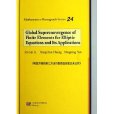《橢圓方程有限元方法的整體超收斂及其套用》一書的出版社是科學出版社有限責任公司,出版時間是第1版 (2012年3月1日)。
基本介紹
- 書名:橢圓方程有限元方法的整體超收斂及其套用
- ISBN:9787030334794
- 頁數:324
- 出版社:科學出版社有限責任公司;
- 出版時間:第1版 (2012年3月1日)
- 開本:16
基本信息,內容簡介,編輯推薦,目錄,
基本信息
出版社: 科學出版社有限責任公司;第1版 (2012年3月1日)
外文書名:Global Superconvergence of Finite Elements for Elliptic Equations and Ints Appli
精裝: 324頁
正文語種: 英語
開本: 16
ISBN: 9787030334794
條形碼: 9787030334794
商品尺寸: 24.2 x 17.2 x 2.2 cm
商品重量: 658 g
內容簡介
《橢圓方程有限元方法的整體超收斂及其套用(英文版)》總結了作者及合作者近十幾年來在有限元高精度算法(主要是整體超收斂分析)方面的主要結果,其中包括許多已發表或尚未發表的成果。本書採用統一的分析方法,即中國學者獨創的積分恆等式方法,對常見的橢圓型偏微分方程的各種有限元方法進行了深入、系統的分析,給出了相應的整體超收斂結果及高精度有限元算法。該書還討論了非線性問題、特徵值問題及差分方法等的整體超收斂,研究了相應的穩定性分析和奇異問題的特殊處理技術,介紹了大量實際套用問題的超收斂分析和數值計算結果,以驗證整體超收斂分析的有效性。
編輯推薦
《橢圓方程有限元方法的整體超收斂及其套用(英文版)》由科學出版社有限責任公司出版。
目錄
Preface
Acknowledgements
Chapter I Basic Approaches
1.1 Introduction
1.2 Simplified Hybrid Combined Methods
1.3 Basic Theorem for Global Superconvergenee
1.4 Bilinear Elements
1.5 Numerical Experiments
1.6 Concluding Remarks
Chapter 2 Adini's Elements
2.1 Introduction
2.2 Adini's Elements
2.3 Global Superconvergence
2.3.1 New error estimates
2.3.2 A posteriori interpolant formulas
2.4 Proof of Theorem 2.3.1
2.4.1 Preliminary lemmas
2.4.2 Main proof of Theorem 2.3.1
2.5 Stability Analysis
2.6 New Stability Analysis via Effective Condition Number.
2.6.1 Computational formulas
2.6.2 Bounds of effective condition number
2.7 Numerical Experiments and Concluding Remarks
Chapter 3 Biquadratic Lagrange Elements
3.1 Introduction
3.2 Biquadratic Lagrange Elements
3.3 Global Superconvergence
3.3.1 New error estimates
3.3.2 Proof of Theorem 3.3.1
3.3.3 Proof of Theorem 3.3.2
3.3.4 Error bounds for Q8 elements
3.4 Numerical Experiments and Discussions
3.4.1 Global superconvergence
3.4.2 Special case of h = k and
3.4.3 Comparisons
3.4.4 Relation between Uh and
3.5 Concluding Remarks
Chapter 4 Simplified Hybrid Method for Motz's Problems
4.1 Introduction
4.2 Simplified Hybrid Combined Methods
4.3 Lagrange Rectangular Elements
4.4 Adini's Elements
4.5 Concluding Remarks
Chapter 5 Finite Difference Methods for Singularity Problem
5.1 Introduction
5.2 The Shortley-Weller Difference Approximation
5.3 Analysis for uD with no Error of Divergence Integration
5.4 Analysis for Uh with Approximation of Divergence Integration..
5.5 Numerical Verification on Reduced Convergence Rates
5.5.1 The model on stripe domains
5.5.2 The Richardson extrapolation and the least squares method
5.6 Concluding Remarks
Chapter 6 Basic Error Estimates for Biharmonic Equations ..
Chapter 7 Stability Analysis and Superconvergence of Blending
Problems
7.1 Introduction
7.2 Description of Numerical Methods
7.3 Stability Analysis
7.3.1 Optimal convergence rates and the uniform V-elliptic inequality.
7.3.2 Bounds of condition number
7.3.3 Proof for Theorem 7.3.4
7.4 Global Superconvergence
7.5 Numerical Experiments and Other Kinds of Superconvergence.. -
7.5.1 Verification of the analysis in Section 7.3 and Section 7.4
7.5.2 New superconvergence of average nodal solutions
7.5.3 Superconvergence of L-norm
7.5.4 Global superconvergence of the a posteriori interpolant solutions
7.6 Concluding Remarks
Chapter 8 Blending Problems in 3D with Periodical Boundary
Conditions
8.1 Introduction
8.2 Biharmouic Equations
8.2.1 Description of numerical methods
8.2.2 Global superconvergence
8.3 The BPH-FEM for Blending Surfaces
8.4 Optimal Convergence and Numerical Stability
8.5 Superconvergence
Chapter 9 Lower Bounds of Leading Eigenvalues
9.1 Introduction
9.1.1 Bilinear element Q1
9.1.2 Rotated Q1 element (Qot)
9.1.3 Extension of rotated Qz element (EQrzt)
9.1.4 Wilson's element
9.2 Basic Theorems
9.3 Bilinea Elements
9.4 QOt and EQrlt Elements
9.4.1 Proof of Lemma 9.4.1
9.4.2 Proof of Lemma 9.4.2
9.4.3 Proof of Lemma 9.4.3
9.4.4 Proof of Lemma 9.4.4
9.5 Wilson's Element
9.5.1 Proof of Lemma 9.5.1
9.5.2 Proof of Lemma 9.5.2
9.5.3 Proof of Lemma 9.5.3 and Lemma 9.5.4
9.6 Expansions for Eigenfunctiens
9.7 Numerical Experiments
9.7.1 Function p=1
9.7.2 Function p=0
9.7.3 Numerical conclusions
Chapter 10 Eigenvalue Problems with Periodical Boundary Conditions
10.1 Introduction
10.2 Periodic Boundary Conditions
10.3 Adini's Elements for Eigenvalue Problems
10.4 Error Analysis for Poisson's Equation
10.5 Superconvergence for Eigenvalue Problems
10.6 Applications to Other Kinds of FEMs
10.6.1 Bi-quadratic Lagrange elements
10.6.2 Triangular elements
10.7 Numerical Results
10.8 Concluding Remarks
Chapter 11 Semilinear Problems
11.1 Introduction
11.2 Parameter-Dependent Semilinear Problems
11.3 Basic Theorems for Superconvergence of FEMs
11.4 Superconvergence of Bi-p(> 2)-Lagrange Elements
11.5 A Continuation Algorithm Using Adini's Elements
11.6 Conclusions
Chapter 12 Epilogue
12.1 Basic Framework of Global Superconvergence
12.2 Some Results on Integral Identity Analysis
12.3 Some Results on Global Superconvergence
Bibliography
Index

